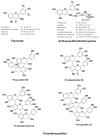Bioactive phytochemicals in barley
- PMID: 28911532
- PMCID: PMC9333424
- DOI: 10.1016/j.jfda.2016.08.002
Bioactive phytochemicals in barley
Abstract
Epidemiological studies have consistently shown that regular consumption of whole grain barley reduces the risk of developing chronic diseases. The presence of barley fiber, especially β-glucan in whole grain barley, has been largely credited for these health benefits. However, it is now widely believed that the actions of the fiber component alone do not explain the observed health benefits associated with the consumption of whole grain barley. Whole grain barley also contains phytochemicals including phenolic acids, flavonoids, lignans, tocols, phytosterols, and folate. These phytochemicals exhibit strong antioxidant, antiproliferative, and cholesterol lowering abilities, which are potentially useful in lowering the risk of certain diseases. Therefore, the high concentration of phytochemicals in barley may be largely responsible for its health benefits. This paper reviews available information regarding barley phytochemicals and their potential to combat common nutrition-related diseases including cancer, cardiovascular disease, diabetes, and obesity.
Keywords: barley; disease prevention; fiber; phytochemicals; whole grain.
Copyright © 2016. Published by Elsevier B.V.
Conflict of interest statement
The authors have no conflict of interest to declare.
Figures






Similar articles
-
Post-anthesis thermal stress induces differential accumulation of bioactive compounds in field-grown barley.J Sci Food Agric. 2021 Dec;101(15):6496-6504. doi: 10.1002/jsfa.11321. Epub 2021 May 28. J Sci Food Agric. 2021. PMID: 34000070
-
Phenolic acids profile, nutritional and phytochemical compounds, antioxidant properties in colored barley grown in southern Italy.Food Res Int. 2018 Nov;113:221-233. doi: 10.1016/j.foodres.2018.06.072. Epub 2018 Jul 14. Food Res Int. 2018. PMID: 30195516
-
Effect of processing on barley β-glucan content, its molecular weight and extractability.Int J Biol Macromol. 2020 Nov 1;162:1204-1216. doi: 10.1016/j.ijbiomac.2020.06.208. Epub 2020 Jun 25. Int J Biol Macromol. 2020. PMID: 32592782 Review.
-
Emerging science on benefits of whole grain oat and barley and their soluble dietary fibers for heart health, glycemic response, and gut microbiota.Nutr Rev. 2020 Aug 1;78(Suppl 1):13-20. doi: 10.1093/nutrit/nuz085. Nutr Rev. 2020. PMID: 32728756 Review.
-
Phytochemical Pharmacokinetics and Bioactivity of Oat and Barley Flour: A Randomized Crossover Trial.Nutrients. 2016 Dec 15;8(12):813. doi: 10.3390/nu8120813. Nutrients. 2016. PMID: 27983687 Free PMC article. Clinical Trial.
Cited by
-
Impact of Rising Temperature in the Deposition Patterns of Bioactive Compounds in Field Grown Food Barley Grains.Plants (Basel). 2021 Mar 22;10(3):598. doi: 10.3390/plants10030598. Plants (Basel). 2021. PMID: 33810185 Free PMC article.
-
Whole Grain Consumption for the Prevention and Treatment of Breast Cancer.Nutrients. 2019 Aug 1;11(8):1769. doi: 10.3390/nu11081769. Nutrients. 2019. PMID: 31374888 Free PMC article. Review.
-
Association of Lifelong Intake of Barley Diet with Healthy Aging: Changes in Physical and Cognitive Functions and Intestinal Microbiome in Senescence-Accelerated Mouse-Prone 8 (SAMP8).Nutrients. 2019 Aug 1;11(8):1770. doi: 10.3390/nu11081770. Nutrients. 2019. PMID: 31374892 Free PMC article.
-
Chemical Composition and Potential Biological Activity of Melanoidins From Instant Soluble Coffee and Instant Soluble Barley: A Comparative Study.Front Nutr. 2022 Feb 10;9:825584. doi: 10.3389/fnut.2022.825584. eCollection 2022. Front Nutr. 2022. PMID: 35223955 Free PMC article.
-
Impact of Fermentation on the Phenolic Compounds and Antioxidant Activity of Whole Cereal Grains: A Mini Review.Molecules. 2020 Feb 19;25(4):927. doi: 10.3390/molecules25040927. Molecules. 2020. PMID: 32093014 Free PMC article. Review.
References
-
- Badr A, Sch R, El Rabey H, Effgen S, Ibrahim H, Pozzi C, Rohde W, Salamini F. On the origin and domestication history of barley (Hordeum vulgare) Mol Biol Evol. 2000;17:499–510. - PubMed
-
- Cook AH. Barley and malt: biology, biochemistry technology. New York: Academic Press; 2013.
-
- Sullivan P, Arendt E, Gallagher E. The increasing use of barley and barley by-products in the production of healthier baked goods. Trends Food Sci Technol. 2013;29:124–34.
-
- Shewry PR, Ullrich SE. Barley: chemistry and technology. American Association of Cereal Chemists, Inc (AACC)/CAB International; Wallingford: 2014.
Publication types
MeSH terms
Substances
LinkOut - more resources
Full Text Sources
Other Literature Sources
